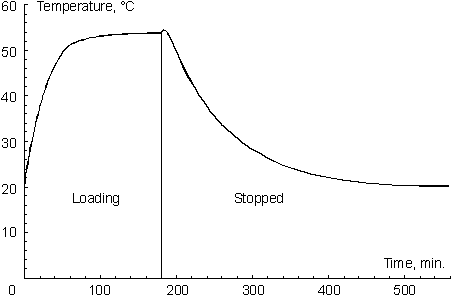
Temperature vs. time dependence at the bottom of the slot (where a temperature sensor usually is placed).
Changing temperature field in the stator tooth zone of power synchronous electric motor during a loading-unloading cycle.
Problem Type:
The plane-parallel problem of heat transfer with convection.
Geometry:
All dimensions are in millimeters. Stator outer diameter is 690 mm. Domain is a 10-degree segment of stator transverse section. Two armature bars laying in the slot release ohmic loss. Cooling is provided by convection to the axial cooling duct and both surfaces of the core.
Given:
| Heat Conductivity (W/K·m) |
Specific Heat (J/kg·K) |
Mass Density (kg/m3) |
|
| Steel Core | 25 | 465 | 7833 |
| Copper Bar | 380 | 380 | 8950 |
| Bar Insulation | 0.15 | 1800 | 1300 |
| Wedge | 0.25 | 1500 | 1400 |
Convection coefficient (W/K·m2) |
||
| Loading | Stopped | |
| Inner stator surface | 250 | 20 |
| Outer stator surface | 70 | 70 |
| Cooling duct | 150 | 20 |
Solution:
Each phase of the loading cycle is modeled by a separate QuickField problem. For the loading phase the initial temperature is set to 20°C, for the cooling phase the initial thermal distribution is imported from the final time moment of the previous solution.
Results:

Temperature vs. time dependence at the bottom of the slot (where a temperature sensor usually is placed).
Please see following problems in the Examples folder:
THeat1Ld.pbm - loading phase,
THeat1S1.pbm - the stopped phase.